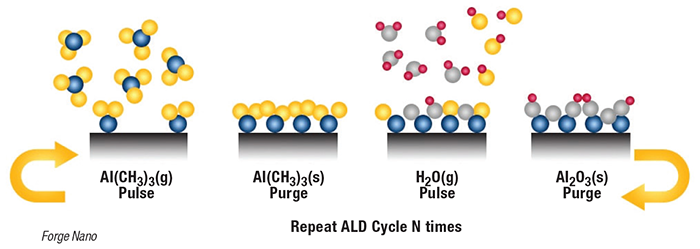Atomic-layer deposition (ALD), a surface engineering technique that applies layers of coatings in a conformal way at single-atom thicknesses, is being investigated for its potential to improve the selectivity and durability of industrial catalysts under a U.S. Dept. of Energy grant awarded earlier this year to Forge Nano Inc. (Thornton, Colo.; www.forgenano.com). The grant will advance the use of Forge Nano’s low-cost ALD techniques for surface engineering of commercial catalyst materials for a range of industrial reactions in food production, petroleum refining and petrochemicals manufacturing.
ALD works by exposing a substrate material to alternating pulses of gaseous “precursor” molecules that react with surfaces in self-limiting ways (diagram). ALD can be used with substances from across the periodic table. In a classic ALD example, a surface with hydroxyl-groups is treated with gaseous trimethylaluminum (TMA; the first precursor). When the surface hydroxyls are completely consumed by the TMA, the reaction stops. In a second step, water (second precursor) is pulsed to replace the methyl groups, leaving a layer of aluminum and regenerating the surface hydroxyl groups for another round of layering, if desired. In this way, single-atom-thick coatings can be applied one layer at a time. “The self-limiting nature of the reactions allows precise control over the formation of the coating,” explains Forge Nano applications engineer Staci Moulton.

Based on research from the University of Colorado-Boulder (www.colorado.edu), the company has developed a set of technologies that allow large-scale ALD use in a variety of application areas and production volumes. Among these technologies is a fluidized-bed reactor for ALD-based coating of particles, in which the precursor gases move upward through a bed of solid substrate material, and a continuous vibrating reactor for high-volume production, in which the solid substrate passes through fixed vessels containing the precursor gases.
The grant advances the use of ALD to overcoat catalyst materials. Forge Nano is also developing the use of ALD to deposit active catalyst materials (in the form of nanoparticle “islands”) onto a high-surface-area support material, and creating ALD undercoats beneath the active catalyst to extend catalyst lifetime and stability without affecting pore size and shape.